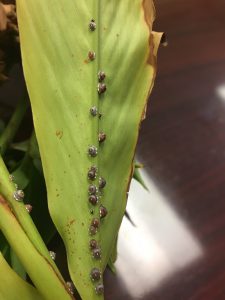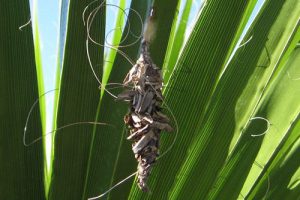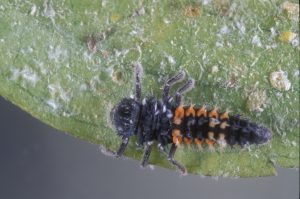
This is the time of year where there is an increase in disease and pest pressures with our high temperatures and summer rains. So if you find bugs on your plants, before you reach for your arsenal of chemicals in your storage shed, it is extremely important to make sure you have correctly identified the pest and consider other methods of control before reaching for those pesticides.
PEST IDENTIFICATION
Less than 1% of the total insect population are considered to be pests; the rest are beneficial insects, insects that feed on other organisms (pests) or non-injurious insects, those that neither harm nor benefit your landscape from a pest perspective. Often times when our office is contacted, by well-intentioned individuals wanting to know what’s bugging their landscape, an action has already been taken, and unfortunately often times it’s the wrong action. Applying a pesticide that is not effective against the pest, applying a fungicide to combat an insect problem, using the wrong dosage and therefore violating the label law, or applying a pesticide to a beneficial organism. These could all lead to unintended environmental consequences. Oftentimes, no action is necessary or economically feasible and a different approach should be considered.
IPM
What is IPM? Integrated Pest Management (IPM) is a sustainable approach to the way we manage our landscape. It promotes the use of the least toxic methods of pest control, pest-resistant plants, and the utilization of natural enemies. Monitor your landscape. By walking around your landscape and periodically inspecting your plants, you will be able to notice any abnormalities or issues that weren’t previously there, and address it while the problem is relatively small. Take an alternative approach. There are a lot of options within your IPM toolbox that you can utilize before even considering a pesticide. Is the level of damage acceptable or not? Some Sri Lanka Weevils (Myllocerus undatus) are not going to cause significant damage to your plants and the plants will be able to handle the periodic feeding.

photo credit: S. Arthurs, UF/IFAS
Mechanical control involves the physical removal of the pest from the plant. A few Croton Scale (Phalacrococcus howertoni) at the tip of your Crotons can easily be wiped off with your fingers or the tips pruned and bagged to keep the infestation from spreading. Handpicking Bagworms (Thyridopteryx ephemeraeformis) and placing them in soapy water will effectively reduce the population.
Cultural control strategies focus on the surrounding environment to minimize pest abundance. Are your plants stressed? Are they not getting enough water; or even worse, are they getting too much water? Plants that are stressed are more susceptible to succumb to pest pressures. Plant more natives! Even though we are situated within the subtropical region of the western hemisphere, our climate is tropical as defined by the Koppean Climate Classification, which defines a tropical climate as non-arid in which all twelve months have mean temperatures of at least 18o C (64o F). Though some have adapted to our conditions, many temperate and non-native plants will not thrive here and will require added nutritional inputs and extra maintenance, especially as sea level continues to rise.
Biological Control employs the good bugs that are already in our natural habitat. By increasing the amount of plant diversity in your landscape, you are encouraging a greater variety of beneficial bugs to the party, thus reducing the necessity of additional control measures. You can also purchase beneficial insects to release into your landscape, but usually there will not be sufficient food supply for them to stick around. The better and more effective option is to encourage variety and limit chemicals.

Photo credit L. Buss, UF/IFAS
Chemical control should be the last resort. There are a lot of natural products that are safer for the environment and our good bug population. For instance, insecticidal soaps and horticultural oils are effective against soft-bodied insects such as aphids, mealybugs, whiteflies, and thrips. Horticultural oils offer more control when it comes to scales. Microbial insecticides are usually targeted for a specific category of insects and contain microorganisms (viruses, bacteria, fungi, etc.) and their toxicity to humans, pets, and wildlife are extremely low. More information about the natural products available and their target organisms can be found in the publication Natural Products for Managing Landscape and Garden Pests in Florida.
PLANT CLINICS
So knowing what bug is bugging your landscape is the first step. UF/IFAS Monroe County Extension Service is here as a resource. We have free regional plant clinics every month and our Master Gardeners can help identify those pesky bugs. Key Largo – 1st and 3rd Wednesday of every month, in room 244, Murray Nelson Government Building. Marathon – 3rd Saturday of every month, at the Home Depot in Marathon. Key West – 1st and 3rd Monday of every month, in Room 2-260, Gato building. All plant clinics go from 9:00 a.m. to 12:00 p.m.
Remember long-term management of pests will always depend on the survival of our natural predators in the landscape and indiscriminant spraying of chemicals will be very damaging to their populations. By applying the IPM strategies, you can help reduce pesticide use in the landscape and conserve biological diversity.
 0
0
